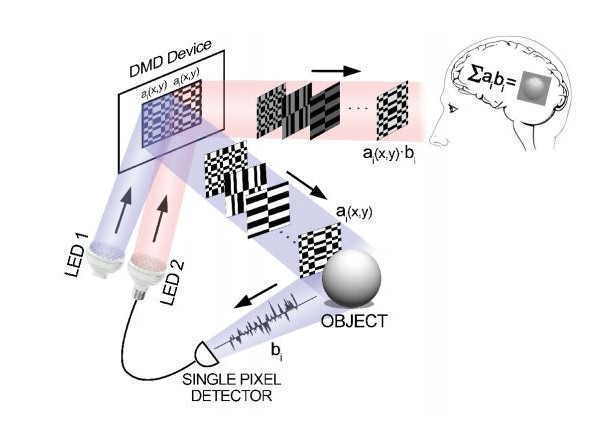Physicists hack the human visual system to create “ghost images”
Ghost imaging is one of the more extraordinary advances in optics in recent years. It produces high-resolution images using single-pixel cameras and light that has never interacted with the object in question.
The technique relies on clever algorithms to crunch the seemingly random data that a single pixel appears to gather. More on that below.
Because of this, it’s easy to imagine that ghost imaging has little relevance for human perception, since the human visual system must be incapable of processing this kind of data.

Not so. Today, Alessandro Boccolini at Heriot-Watt University in Edinburgh, Scotland, and a couple of colleagues demonstrate that humans can see ghost images and suggest how the technique can be used to study and exploit the visual system in entirely new ways.
First some background. Ghost imaging works by projecting a random pattern of light onto an object and recording the reflected light with a single pixel. Repeating this process with differnet random patterns of light produces a sequence of data points about how the light intensity varies over time.
It’s easy to think these data points must vary at random. But they are actually correlated, because the light reflects off the same object. So crunching the data in the right kind of way can reveal this correlation: an image of the object.
Not all this processing need be done in a computer. One shortcut is to use the signal from the single pixel to modulate the light output from another LED. This is then projected onto the same random pattern, and the process repeated for the next pattern, and so on.
The image of the object—the ghost image—can then be reconstructed by integrating the reflected light from a long sequence of random patterns illuminated. Interestingly, the resulting image is formed from light that has never interacted with the original object.
The question that Boccolini and co investigate is whether the human visual system can perform this integration process. Their idea is to project the patterns in quick succession onto a screen that somebody is watching and then see if the person’s visual system will combine them.
A similar effect allows us to perceive a sequence of still images as continuous movement. But it is by no means obvious that the visual system will integrate the random patterns, each of which is a random arrangement of black and white pixels called a Hadamard pattern.
The only way to find out is to try the experiment on some willing victims. Boccolini and co asked four human subjects to view the projected patterns. These guinea pigs could change the rate at which the patterns appeared to see how this changed their experience.
The results are fascinating. Boccolini and co say that when the patterns appear at a relatively slow rate, the human eye sees only a set of square pixels. But when the rate crosses some threshold, the image of the object suddenly appears.
The threshold is clearly an important property of human vision. The experimental setup is capable of projecting patterns at a rate of 20 kilohertz; that allows 200 Hadamard patterns to appear every 20 milliseconds.
Boccolini and co say that all four subjects could see the object at this rate. So the visual system must be integrating a sequence of images in a specific way. But the image quickly degrades when the rate falls below 200 patterns per 20 milliseconds.
This is an entirely new visual phenomenon and provides a new tool to study the visual system. ““We use this human ghost imaging technique to evaluate the temporal response of the eye and establish the image persistence time to be around 20 ms followed by a further 20 ms exponential decay,” say the team.
The fact that the eye never interacts with light that has hit the object opens up some fascinating possibilities, not least the prospect of illuminating the object with one wavelength and then perceiving it at another. Indeed, the illuminating wavelength need not be visible by the human eye.
“Ghost-imaging with the eye opens up a number of completely novel applications such as extending human vision into invisible wavelength regimes in real time,” say Boccolini and co. This requires no additional viewing screen or computational steps, since the human vision system does almost all the work.
However, Boccolini and co are most interested in how this new tool can help them study the visual system in more detail. One idea is to investigate whether the visual system is capable of even more computation. The team hopes to study this by beaming different patterns into each eye or onto different parts of the retina to see whether the visual system can still integrate the data to produce an image.
That’ll be interesting work, worth watching.
Ref: arxiv.org/abs/1808.05137 : Ghost Imaging With The Human Eye
Deep Dive
Computing
Inside the hunt for new physics at the world’s largest particle collider
The Large Hadron Collider hasn’t seen any new particles since the discovery of the Higgs boson in 2012. Here’s what researchers are trying to do about it.
How ASML took over the chipmaking chessboard
MIT Technology Review sat down with outgoing CTO Martin van den Brink to talk about the company’s rise to dominance and the life and death of Moore’s Law.
How Wi-Fi sensing became usable tech
After a decade of obscurity, the technology is being used to track people’s movements.
Algorithms are everywhere
Three new books warn against turning into the person the algorithm thinks you are.
Stay connected
Get the latest updates from
MIT Technology Review
Discover special offers, top stories, upcoming events, and more.